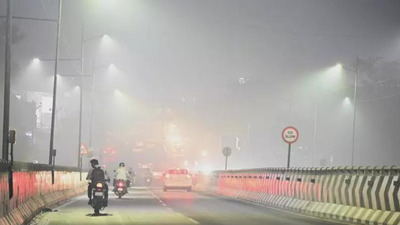Thane: Air turns toxic, noise levels rise after Diwali firecrackers; civic data shows pollution spike
THANE: Even as citizens celebrated the festival of lights with great enthusiasm, the widespread use of fancy and noisy firecrackers not only pushed the city’s air quality to nearly toxic levels but also caused a rise in sound levels, according to data released by the Thane Municipal Corporation (TMC).
While brief evening showers offered temporary relief, they failed to improve the overall Air Quality Index (AQI). The AQI, which was 141 before Diwali, rose to 157 on Lakshmi Pujan day on October 21, marking a significant deterioration in air quality, revealed a comparative study conducted by the TMC’s Pollution Control Department.

Video
“There was an increase in nitrogen oxides and sulphur dioxide levels, both considered harmful to respiratory health. Rain offered temporary relief, but pollutants returned almost immediately as a sudden spike in dust particles was recorded after the showers stopped. There needs to be a shift towards eco-friendly and green firecrackers,” said Chief Environmental Officer Manisha Pradhan, who led the study.
Noise levels also saw a 3.2% increase, with peak sound levels rising from 86 Lmax last year to 89.2 Lmax this Diwali, the data showed. Experts warned that even a single unit increase could cause severe harm to hearing.
Anti-noise activist Dr Mahesh Bedekar said the authorities must spread awareness about the harmful effects of noisy crackers, while residents should also realise the damage they are causing to their environment. He added that police could assist by conducting special rounds and enforcing the ban on bursting crackers after 10 pm.
“We must realise that the pollution will eventually affect our family members, who will end up visiting doctors for respiratory ailments after the festive season,” he said.
Meanwhile, several upscale localities along Ghodbunder Highway, Vartak Nagar, and Naupada continued to witness the bursting of crackers late into the night until Diwali Padwa, leaving the elderly and unwell residents most affected. Animal lovers and pet owners also complained about the distress caused to pets and urged people to switch to noiseless firecrackers.
While brief evening showers offered temporary relief, they failed to improve the overall Air Quality Index (AQI). The AQI, which was 141 before Diwali, rose to 157 on Lakshmi Pujan day on October 21, marking a significant deterioration in air quality, revealed a comparative study conducted by the TMC’s Pollution Control Department.
Video
“There was an increase in nitrogen oxides and sulphur dioxide levels, both considered harmful to respiratory health. Rain offered temporary relief, but pollutants returned almost immediately as a sudden spike in dust particles was recorded after the showers stopped. There needs to be a shift towards eco-friendly and green firecrackers,” said Chief Environmental Officer Manisha Pradhan, who led the study.
Noise levels also saw a 3.2% increase, with peak sound levels rising from 86 Lmax last year to 89.2 Lmax this Diwali, the data showed. Experts warned that even a single unit increase could cause severe harm to hearing.
Anti-noise activist Dr Mahesh Bedekar said the authorities must spread awareness about the harmful effects of noisy crackers, while residents should also realise the damage they are causing to their environment. He added that police could assist by conducting special rounds and enforcing the ban on bursting crackers after 10 pm.
“We must realise that the pollution will eventually affect our family members, who will end up visiting doctors for respiratory ailments after the festive season,” he said.
Meanwhile, several upscale localities along Ghodbunder Highway, Vartak Nagar, and Naupada continued to witness the bursting of crackers late into the night until Diwali Padwa, leaving the elderly and unwell residents most affected. Animal lovers and pet owners also complained about the distress caused to pets and urged people to switch to noiseless firecrackers.
Next Story